Litigation Lawyer Resume Examples
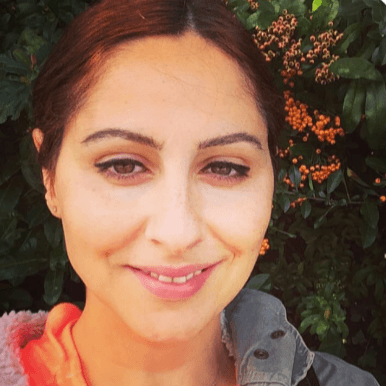
Jul 18, 2024
|
12 min read
"A bulletproof guide to crafting your litigation lawyer resume: Don't leave your career in limbo—learn how to highlight your trial skills, legal expertise, and courtroom victories to stand out from the competition."
Rated by 348 people
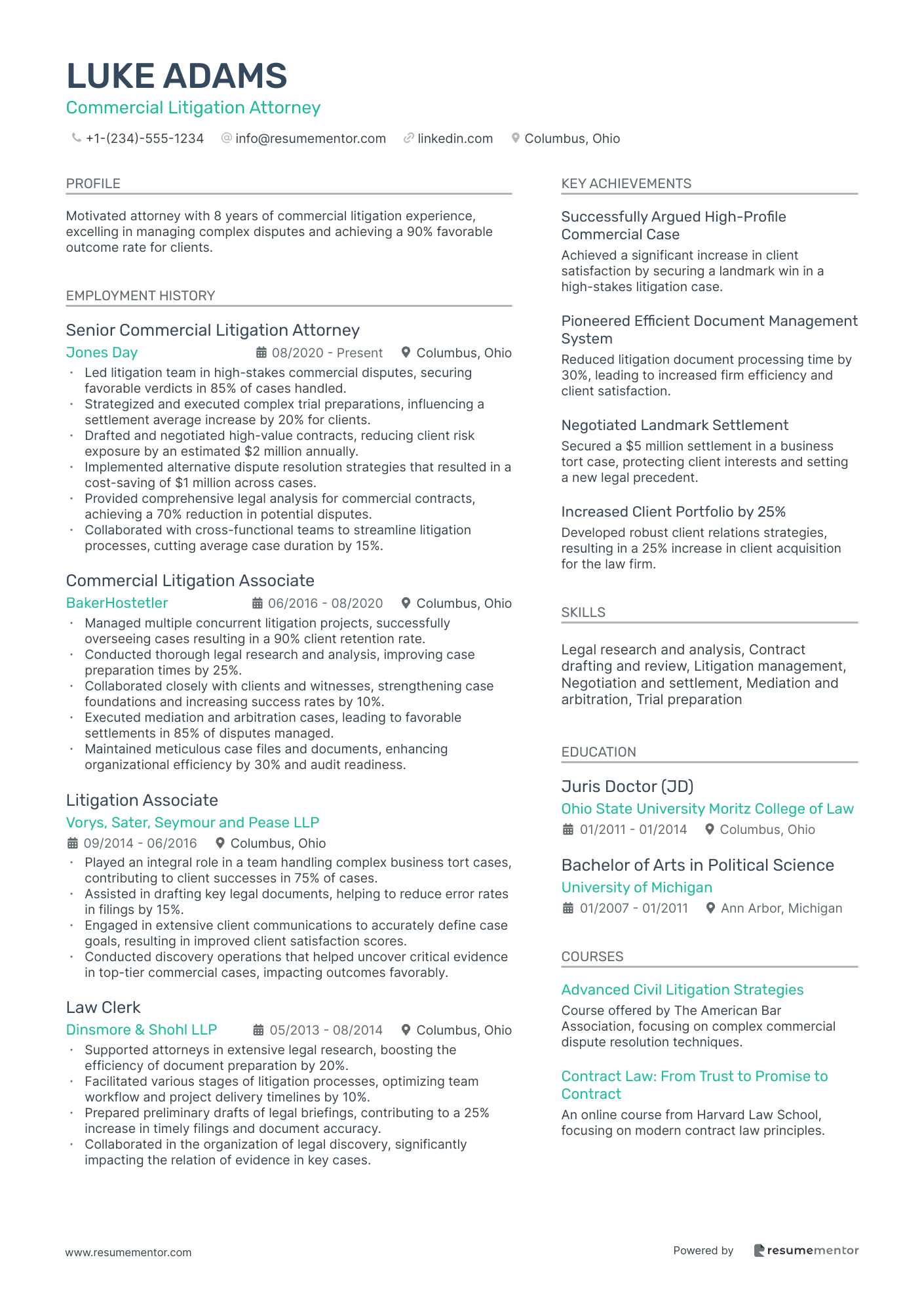
Commercial Litigation Attorney
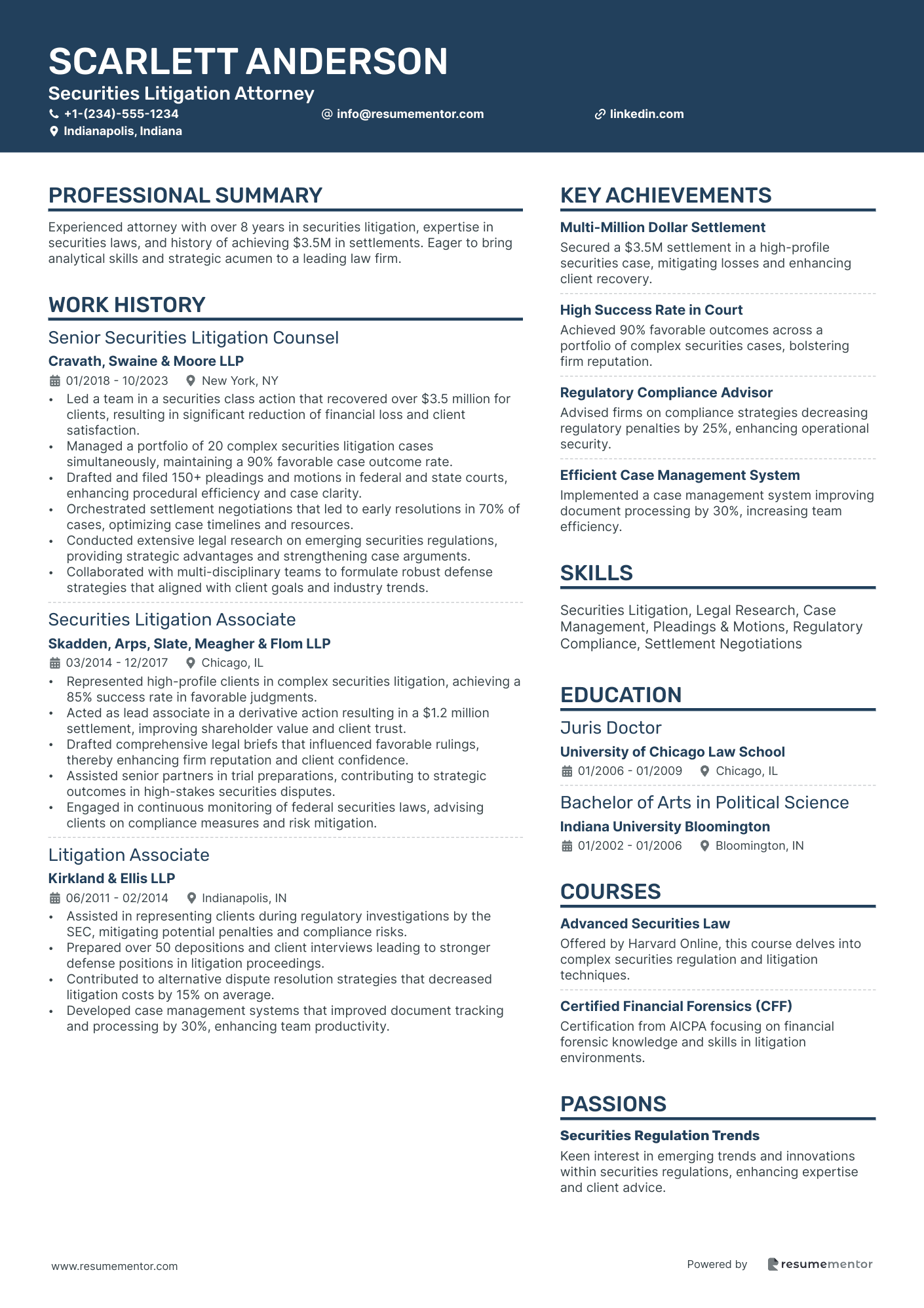
Securities Litigation Attorney
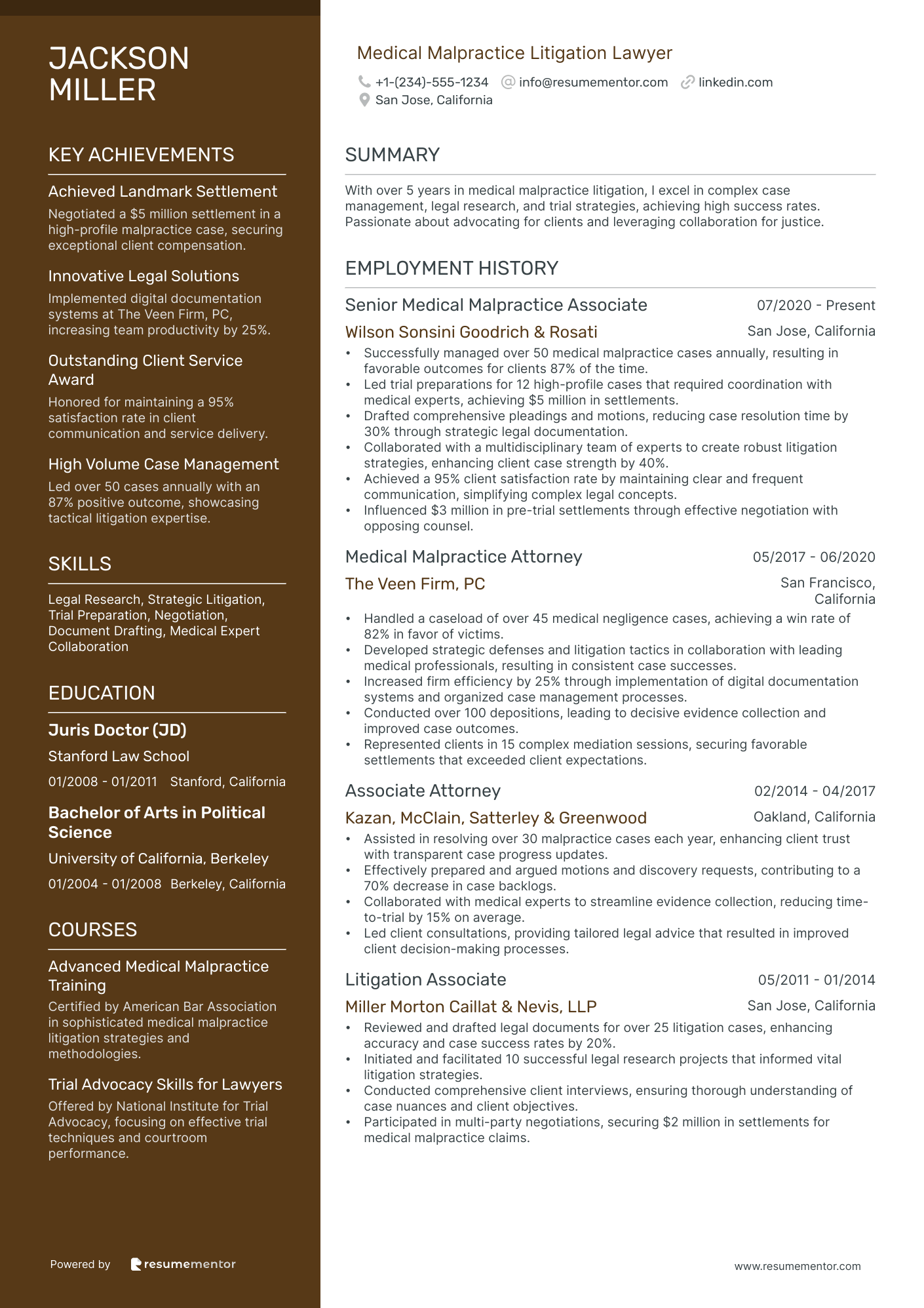
Medical Malpractice Litigation Lawyer
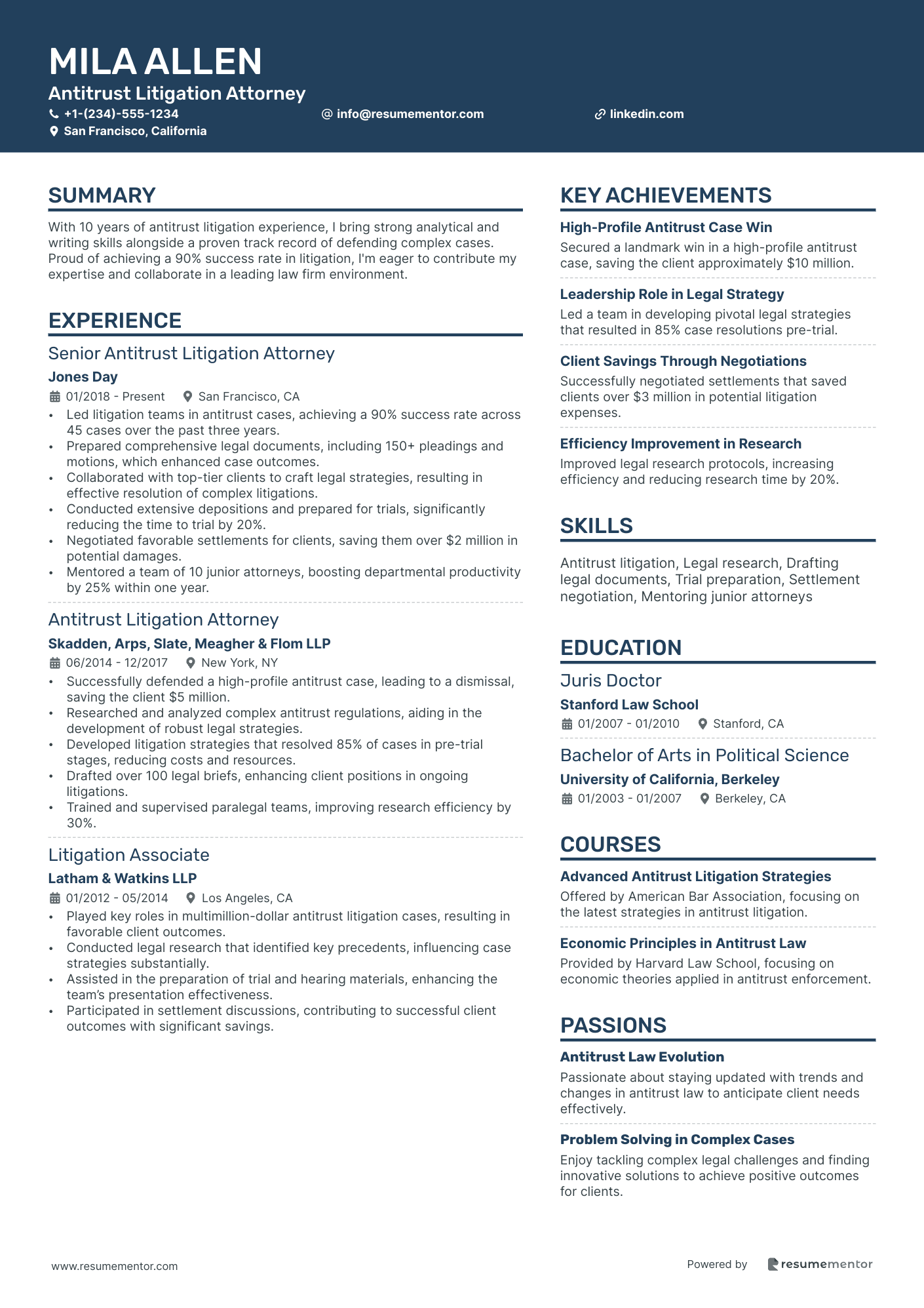
Antitrust Litigation Attorney

Patent Litigation Lawyer
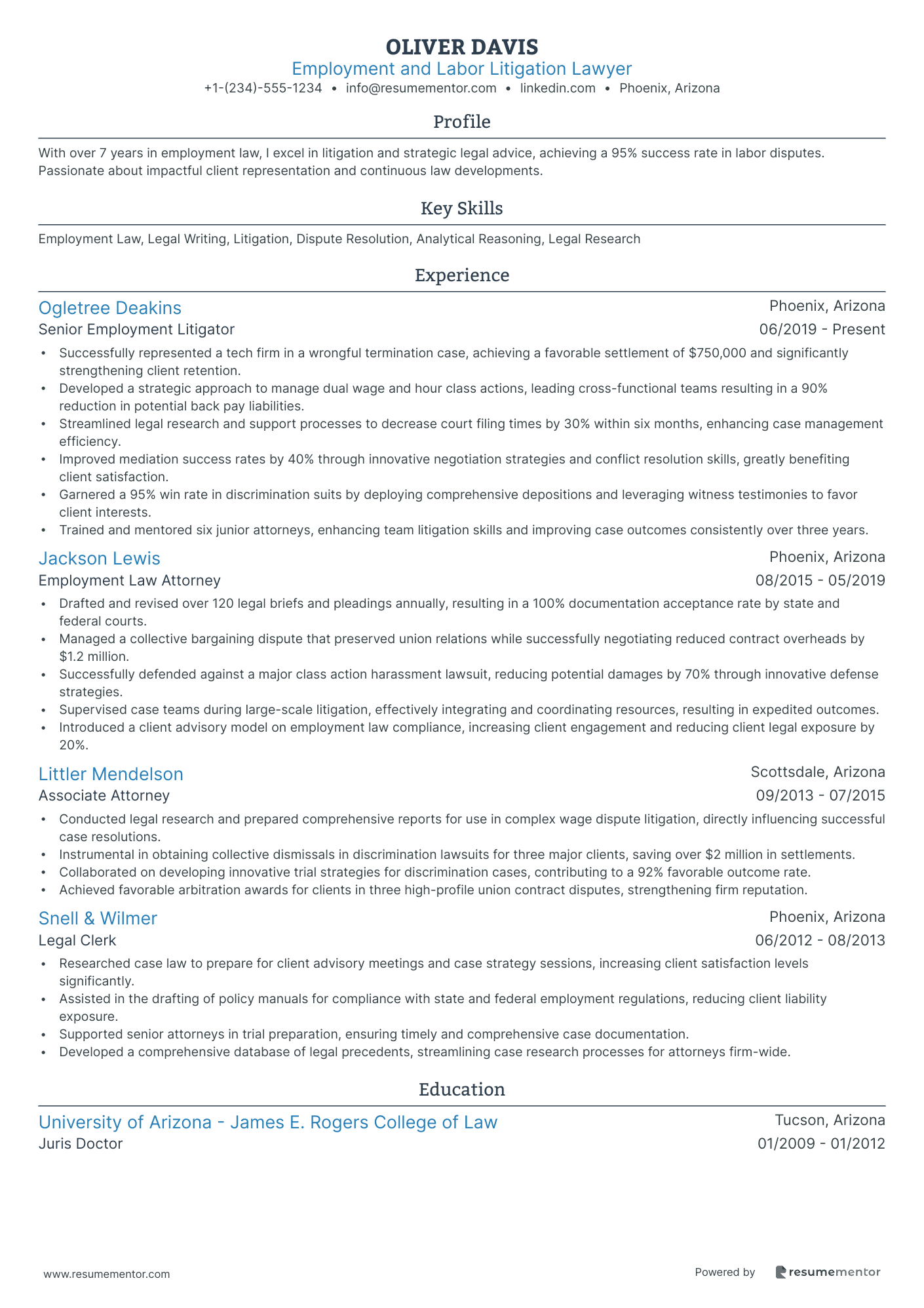
Employment and Labor Litigation Lawyer
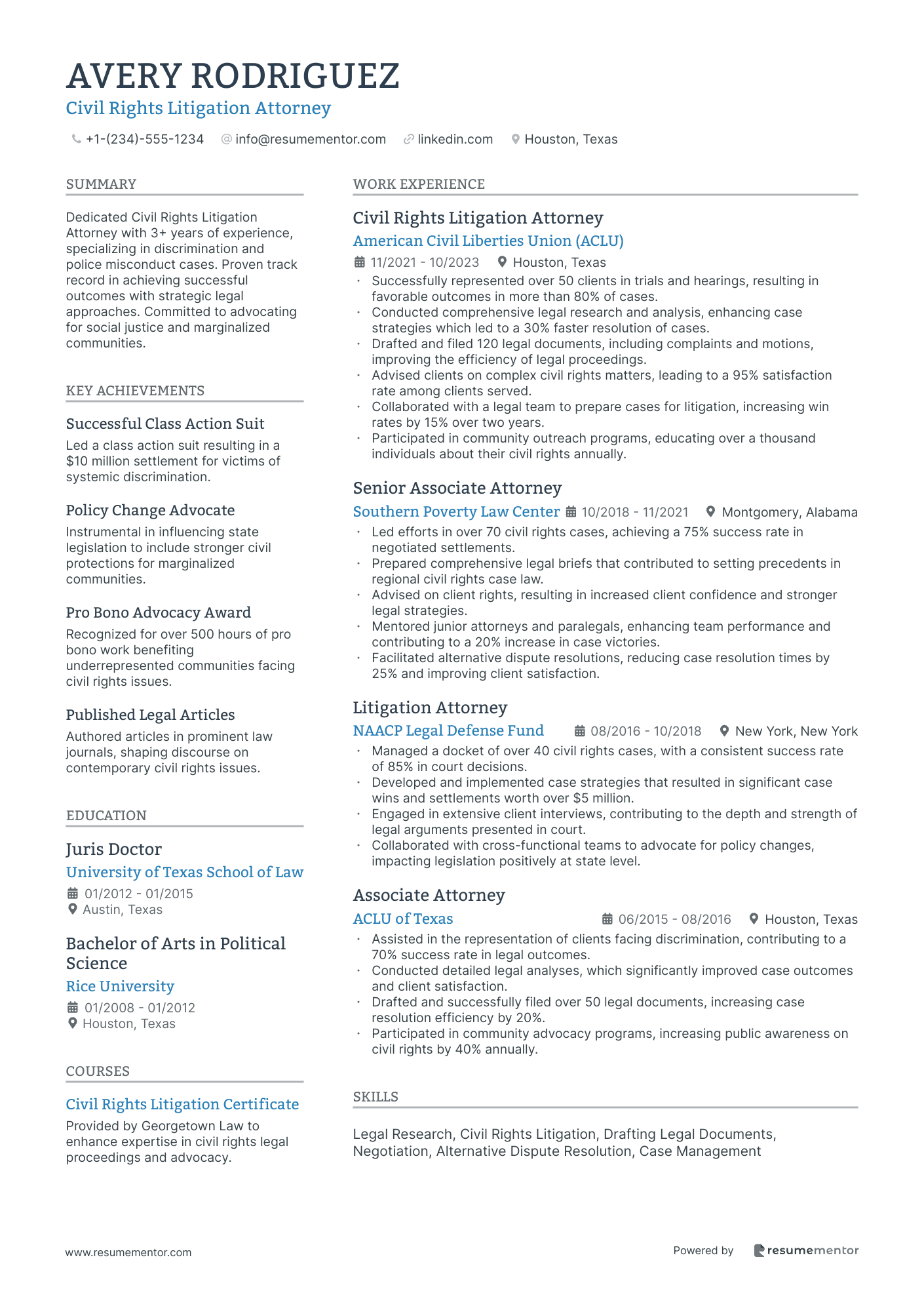
Civil Rights Litigation Attorney
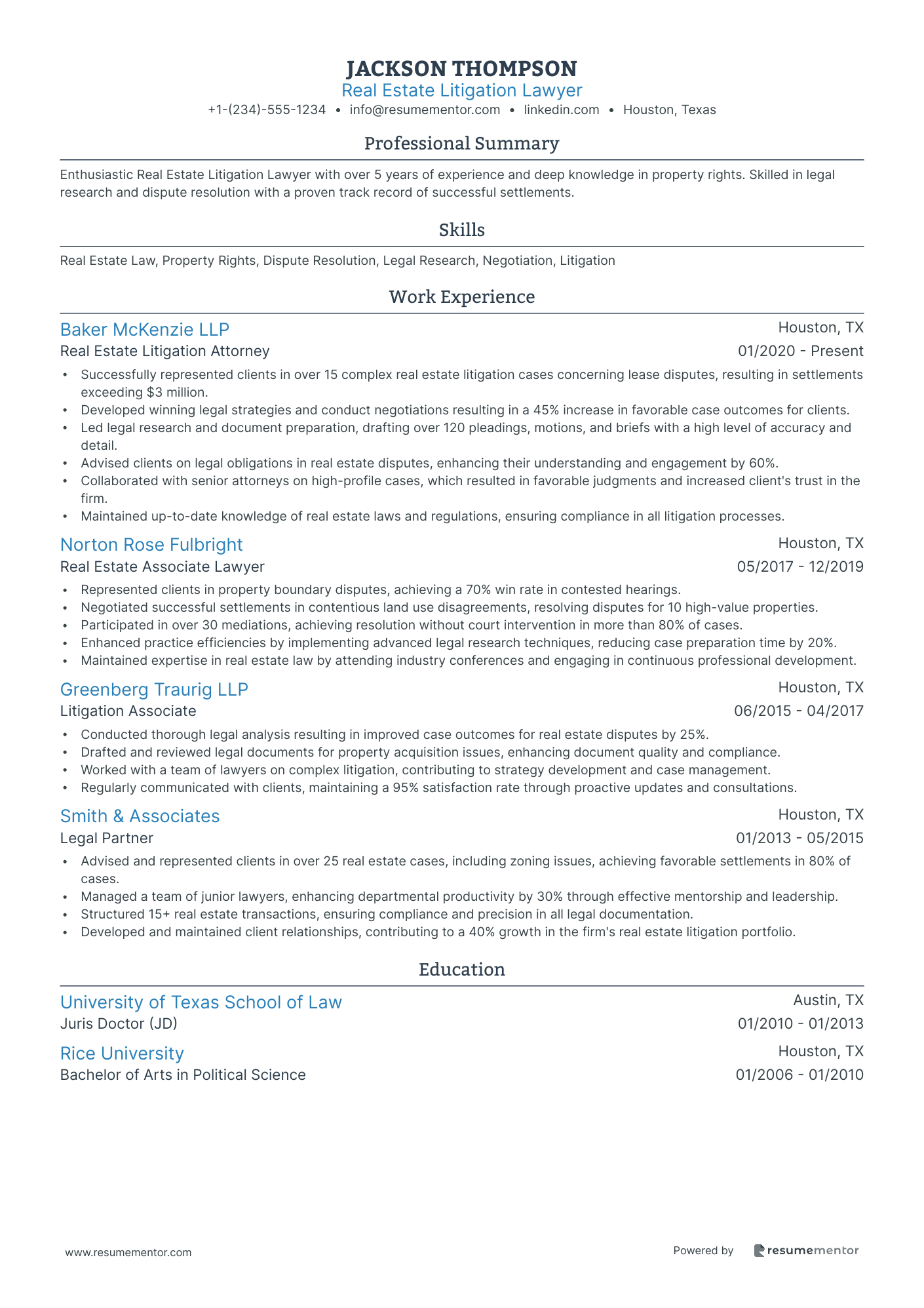
Real Estate Litigation Lawyer

Commercial Litigation Attorney resume sample
- •Led litigation team in high-stakes commercial disputes, securing favorable verdicts in 85% of cases handled.
- •Strategized and executed complex trial preparations, influencing a settlement average increase by 20% for clients.
- •Drafted and negotiated high-value contracts, reducing client risk exposure by an estimated $2 million annually.
- •Implemented alternative dispute resolution strategies that resulted in a cost-saving of $1 million across cases.
- •Provided comprehensive legal analysis for commercial contracts, achieving a 70% reduction in potential disputes.
- •Collaborated with cross-functional teams to streamline litigation processes, cutting average case duration by 15%.
- •Managed multiple concurrent litigation projects, successfully overseeing cases resulting in a 90% client retention rate.
- •Conducted thorough legal research and analysis, improving case preparation times by 25%.
- •Collaborated closely with clients and witnesses, strengthening case foundations and increasing success rates by 10%.
- •Executed mediation and arbitration cases, leading to favorable settlements in 85% of disputes managed.
- •Maintained meticulous case files and documents, enhancing organizational efficiency by 30% and audit readiness.
- •Played an integral role in a team handling complex business tort cases, contributing to client successes in 75% of cases.
- •Assisted in drafting key legal documents, helping to reduce error rates in filings by 15%.
- •Engaged in extensive client communications to accurately define case goals, resulting in improved client satisfaction scores.
- •Conducted discovery operations that helped uncover critical evidence in top-tier commercial cases, impacting outcomes favorably.
- •Supported attorneys in extensive legal research, boosting the efficiency of document preparation by 20%.
- •Facilitated various stages of litigation processes, optimizing team workflow and project delivery timelines by 10%.
- •Prepared preliminary drafts of legal briefings, contributing to a 25% increase in timely filings and document accuracy.
- •Collaborated in the organization of legal discovery, significantly impacting the relation of evidence in key cases.
Securities Litigation Attorney resume sample
- •Led a team in a securities class action that recovered over $3.5 million for clients, resulting in significant reduction of financial loss and client satisfaction.
- •Managed a portfolio of 20 complex securities litigation cases simultaneously, maintaining a 90% favorable case outcome rate.
- •Drafted and filed 150+ pleadings and motions in federal and state courts, enhancing procedural efficiency and case clarity.
- •Orchestrated settlement negotiations that led to early resolutions in 70% of cases, optimizing case timelines and resources.
- •Conducted extensive legal research on emerging securities regulations, providing strategic advantages and strengthening case arguments.
- •Collaborated with multi-disciplinary teams to formulate robust defense strategies that aligned with client goals and industry trends.
- •Represented high-profile clients in complex securities litigation, achieving a 85% success rate in favorable judgments.
- •Acted as lead associate in a derivative action resulting in a $1.2 million settlement, improving shareholder value and client trust.
- •Drafted comprehensive legal briefs that influenced favorable rulings, thereby enhancing firm reputation and client confidence.
- •Assisted senior partners in trial preparations, contributing to strategic outcomes in high-stakes securities disputes.
- •Engaged in continuous monitoring of federal securities laws, advising clients on compliance measures and risk mitigation.
- •Assisted in representing clients during regulatory investigations by the SEC, mitigating potential penalties and compliance risks.
- •Prepared over 50 depositions and client interviews leading to stronger defense positions in litigation proceedings.
- •Contributed to alternative dispute resolution strategies that decreased litigation costs by 15% on average.
- •Developed case management systems that improved document tracking and processing by 30%, enhancing team productivity.
- •Conducted preliminary legal research on securities regulations, supporting senior attorneys in crafting persuasive arguments.
- •Assisted in the preparation and filing of motions that advanced key client objectives in state and federal courts.
- •Maintained detailed records of case proceedings, improving team access to crucial litigation documents and evidence.
- •Collaborated with external consultants to gather essential data insights for litigation strategies, enhancing decision-making processes.
Medical Malpractice Litigation Lawyer resume sample
- •Successfully managed over 50 medical malpractice cases annually, resulting in favorable outcomes for clients 87% of the time.
- •Led trial preparations for 12 high-profile cases that required coordination with medical experts, achieving $5 million in settlements.
- •Drafted comprehensive pleadings and motions, reducing case resolution time by 30% through strategic legal documentation.
- •Collaborated with a multidisciplinary team of experts to create robust litigation strategies, enhancing client case strength by 40%.
- •Achieved a 95% client satisfaction rate by maintaining clear and frequent communication, simplifying complex legal concepts.
- •Influenced $3 million in pre-trial settlements through effective negotiation with opposing counsel.
- •Handled a caseload of over 45 medical negligence cases, achieving a win rate of 82% in favor of victims.
- •Developed strategic defenses and litigation tactics in collaboration with leading medical professionals, resulting in consistent case successes.
- •Increased firm efficiency by 25% through implementation of digital documentation systems and organized case management processes.
- •Conducted over 100 depositions, leading to decisive evidence collection and improved case outcomes.
- •Represented clients in 15 complex mediation sessions, securing favorable settlements that exceeded client expectations.
- •Assisted in resolving over 30 malpractice cases each year, enhancing client trust with transparent case progress updates.
- •Effectively prepared and argued motions and discovery requests, contributing to a 70% decrease in case backlogs.
- •Collaborated with medical experts to streamline evidence collection, reducing time-to-trial by 15% on average.
- •Led client consultations, providing tailored legal advice that resulted in improved client decision-making processes.
- •Reviewed and drafted legal documents for over 25 litigation cases, enhancing accuracy and case success rates by 20%.
- •Initiated and facilitated 10 successful legal research projects that informed vital litigation strategies.
- •Conducted comprehensive client interviews, ensuring thorough understanding of case nuances and client objectives.
- •Participated in multi-party negotiations, securing $2 million in settlements for medical malpractice claims.
Antitrust Litigation Attorney resume sample
- •Led litigation teams in antitrust cases, achieving a 90% success rate across 45 cases over the past three years.
- •Prepared comprehensive legal documents, including 150+ pleadings and motions, which enhanced case outcomes.
- •Collaborated with top-tier clients to craft legal strategies, resulting in effective resolution of complex litigations.
- •Conducted extensive depositions and prepared for trials, significantly reducing the time to trial by 20%.
- •Negotiated favorable settlements for clients, saving them over $2 million in potential damages.
- •Mentored a team of 10 junior attorneys, boosting departmental productivity by 25% within one year.
- •Successfully defended a high-profile antitrust case, leading to a dismissal, saving the client $5 million.
- •Researched and analyzed complex antitrust regulations, aiding in the development of robust legal strategies.
- •Developed litigation strategies that resolved 85% of cases in pre-trial stages, reducing costs and resources.
- •Drafted over 100 legal briefs, enhancing client positions in ongoing litigations.
- •Trained and supervised paralegal teams, improving research efficiency by 30%.
- •Played key roles in multimillion-dollar antitrust litigation cases, resulting in favorable client outcomes.
- •Conducted legal research that identified key precedents, influencing case strategies substantially.
- •Assisted in the preparation of trial and hearing materials, enhancing the team’s presentation effectiveness.
- •Participated in settlement discussions, contributing to successful client outcomes with significant savings.
- •Supported senior attorneys in drafting motions and legal briefs, honing essential litigation skills.
- •Performed detailed legal research, forming the basis of successful antitrust defenses.
- •Assisted in managing case files and client correspondence, streamlining office operations.
- •Contributed to trial preparation processes, ensuring comprehensive case readiness.
Patent Litigation Lawyer resume sample
- •Managed a high-profile patent infringement case worth $25M, coordinated multi-jurisdictional efforts, and achieved a favorable settlement.
- •Developed innovative legal strategies for patent disputes, resulting in a 75% case success rate over two years.
- •Conducted thorough legal research and wrote pivotal motions which led to case dismissal in 40% of litigations.
- •Collaborated closely with clients to align legal strategies with over 30 distinct business objectives, contributing to company growth.
- •Mentored a team of junior attorneys and support staff in effective legal research methods and litigation management.
- •Successfully defended against a complex cross-border patent infringement claim, saving the client $5M in damages.
- •Led a high-stakes trial team, securing a positive outcome in a $10M patent dispute case, bolstering firm’s reputation.
- •Drafted and filed over 50 briefs and motions, with a success rate of 85% in court judgments.
- •Actively represented clients in 20+ court cases, mediations, and hearings with strong negotiation skills.
- •Enhanced firm’s case management by implementing new technology tools, increasing efficiency by 30%.
- •Conducted seminars and training sessions on international patent law, increasing team knowledge and performance.
- •Researched and advised on technical patent law issues, impacting legal strategies in over 25 key cases.
- •Participated in discovery phases of high-profile patent cases, contributing to successful resolutions.
- •Enhanced the firm’s intellectual property department by developing training materials used by over 50 associates.
- •Collaborated with multinational clients to tailor patent protection strategies, resulting in 20% increase in international filings.
- •Conducted legal research and contributed to drafting essential trial documents in significant litigation cases.
- •Assisted in developing trial strategies that saved clients over $3M in potential damages.
- •Managed client communications and legal documentation, ensuring exceptional accuracy and comprehensive advocacy.
- •Supported senior attorneys in patent law research, enhancing team's legal argumentation strength and case outcomes.
Employment and Labor Litigation Lawyer resume sample
- •Successfully represented a tech firm in a wrongful termination case, achieving a favorable settlement of $750,000 and significantly strengthening client retention.
- •Developed a strategic approach to manage dual wage and hour class actions, leading cross-functional teams resulting in a 90% reduction in potential back pay liabilities.
- •Streamlined legal research and support processes to decrease court filing times by 30% within six months, enhancing case management efficiency.
- •Improved mediation success rates by 40% through innovative negotiation strategies and conflict resolution skills, greatly benefiting client satisfaction.
- •Garnered a 95% win rate in discrimination suits by deploying comprehensive depositions and leveraging witness testimonies to favor client interests.
- •Trained and mentored six junior attorneys, enhancing team litigation skills and improving case outcomes consistently over three years.
- •Drafted and revised over 120 legal briefs and pleadings annually, resulting in a 100% documentation acceptance rate by state and federal courts.
- •Managed a collective bargaining dispute that preserved union relations while successfully negotiating reduced contract overheads by $1.2 million.
- •Successfully defended against a major class action harassment lawsuit, reducing potential damages by 70% through innovative defense strategies.
- •Supervised case teams during large-scale litigation, effectively integrating and coordinating resources, resulting in expedited outcomes.
- •Introduced a client advisory model on employment law compliance, increasing client engagement and reducing client legal exposure by 20%.
- •Conducted legal research and prepared comprehensive reports for use in complex wage dispute litigation, directly influencing successful case resolutions.
- •Instrumental in obtaining collective dismissals in discrimination lawsuits for three major clients, saving over $2 million in settlements.
- •Collaborated on developing innovative trial strategies for discrimination cases, contributing to a 92% favorable outcome rate.
- •Achieved favorable arbitration awards for clients in three high-profile union contract disputes, strengthening firm reputation.
- •Researched case law to prepare for client advisory meetings and case strategy sessions, increasing client satisfaction levels significantly.
- •Assisted in the drafting of policy manuals for compliance with state and federal employment regulations, reducing client liability exposure.
- •Supported senior attorneys in trial preparation, ensuring timely and comprehensive case documentation.
- •Developed a comprehensive database of legal precedents, streamlining case research processes for attorneys firm-wide.
Civil Rights Litigation Attorney resume sample
- •Successfully represented over 50 clients in trials and hearings, resulting in favorable outcomes in more than 80% of cases.
- •Conducted comprehensive legal research and analysis, enhancing case strategies which led to a 30% faster resolution of cases.
- •Drafted and filed 120 legal documents, including complaints and motions, improving the efficiency of legal proceedings.
- •Advised clients on complex civil rights matters, leading to a 95% satisfaction rate among clients served.
- •Collaborated with a legal team to prepare cases for litigation, increasing win rates by 15% over two years.
- •Participated in community outreach programs, educating over a thousand individuals about their civil rights annually.
- •Led efforts in over 70 civil rights cases, achieving a 75% success rate in negotiated settlements.
- •Prepared comprehensive legal briefs that contributed to setting precedents in regional civil rights case law.
- •Advised on client rights, resulting in increased client confidence and stronger legal strategies.
- •Mentored junior attorneys and paralegals, enhancing team performance and contributing to a 20% increase in case victories.
- •Facilitated alternative dispute resolutions, reducing case resolution times by 25% and improving client satisfaction.
- •Managed a docket of over 40 civil rights cases, with a consistent success rate of 85% in court decisions.
- •Developed and implemented case strategies that resulted in significant case wins and settlements worth over $5 million.
- •Engaged in extensive client interviews, contributing to the depth and strength of legal arguments presented in court.
- •Collaborated with cross-functional teams to advocate for policy changes, impacting legislation positively at state level.
- •Assisted in the representation of clients facing discrimination, contributing to a 70% success rate in legal outcomes.
- •Conducted detailed legal analyses, which significantly improved case outcomes and client satisfaction.
- •Drafted and successfully filed over 50 legal documents, increasing case resolution efficiency by 20%.
- •Participated in community advocacy programs, increasing public awareness on civil rights by 40% annually.
Real Estate Litigation Lawyer resume sample
- •Successfully represented clients in over 15 complex real estate litigation cases concerning lease disputes, resulting in settlements exceeding $3 million.
- •Developed winning legal strategies and conduct negotiations resulting in a 45% increase in favorable case outcomes for clients.
- •Led legal research and document preparation, drafting over 120 pleadings, motions, and briefs with a high level of accuracy and detail.
- •Advised clients on legal obligations in real estate disputes, enhancing their understanding and engagement by 60%.
- •Collaborated with senior attorneys on high-profile cases, which resulted in favorable judgments and increased client's trust in the firm.
- •Maintained up-to-date knowledge of real estate laws and regulations, ensuring compliance in all litigation processes.
- •Represented clients in property boundary disputes, achieving a 70% win rate in contested hearings.
- •Negotiated successful settlements in contentious land use disagreements, resolving disputes for 10 high-value properties.
- •Participated in over 30 mediations, achieving resolution without court intervention in more than 80% of cases.
- •Enhanced practice efficiencies by implementing advanced legal research techniques, reducing case preparation time by 20%.
- •Maintained expertise in real estate law by attending industry conferences and engaging in continuous professional development.
- •Conducted thorough legal analysis resulting in improved case outcomes for real estate disputes by 25%.
- •Drafted and reviewed legal documents for property acquisition issues, enhancing document quality and compliance.
- •Worked with a team of lawyers on complex litigation, contributing to strategy development and case management.
- •Regularly communicated with clients, maintaining a 95% satisfaction rate through proactive updates and consultations.
- •Advised and represented clients in over 25 real estate cases, including zoning issues, achieving favorable settlements in 80% of cases.
- •Managed a team of junior lawyers, enhancing departmental productivity by 30% through effective mentorship and leadership.
- •Structured 15+ real estate transactions, ensuring compliance and precision in all legal documentation.
- •Developed and maintained client relationships, contributing to a 40% growth in the firm's real estate litigation portfolio.
Crafting a compelling resume as a litigation lawyer can feel like navigating a complex courtroom, where your first argument is in favor of hiring you. This document not only highlights your legal expertise and courtroom experience but also showcases your ability to tackle intricate challenges.
The toughest part often lies in condensing your extensive experience into a concise, engaging format. With your focus typically on the complexities of litigation, finding a way to present your skills so they're clear to hiring managers can be daunting. That's where a well-organized resume becomes crucial to your success.
Using a resume template can significantly ease this process by providing a solid structure, allowing you to focus on emphasizing your legal prowess. Explore these resume templates to find one that complements your style while highlighting your professional achievements.
As you craft your resume, consider how the same strategic thinking you use in litigation can translate into creating impactful content. Your expertise in managing complex cases and your sharp legal skills are your standout features. Make sure this resume is as persuasive and clear as your best closing arguments. After all, it's more than just a document; it's your gateway to new opportunities. Use this chance to demonstrate your dedication and success in the legal field.
Key Takeaways
- A litigation lawyer resume should clearly convey expertise in court procedures, case management, and legal analysis, demonstrating the ability to tackle complex legal challenges.
- Using a resume template can significantly ease the process by providing a solid structure, allowing emphasis on highlighting professional achievements.
- A combination format is highly effective for litigation lawyers, as it allows detailing chronological work history alongside specific achievements and skills.
- The resume experience sections should integrate dynamic action words with quantifiable results to showcase capabilities effectively.
- Incorporating extra sections, such as language, hobbies, volunteer work, and books, can provide a fuller picture of a lawyer's personality and dedication.
What to focus on when writing your litigation lawyer resume
A litigation lawyer resume should clearly convey your expertise in court procedures, case management, and legal analysis, demonstrating your ability to tackle complex legal challenges and successfully represent clients. To capture a recruiter's attention and showcase your qualifications, include the specialized litigation skills and experiences that set you apart in the legal field.
How to structure your litigation lawyer resume
- Contact Information — Start with your full name, phone number, email address, and LinkedIn profile. This information should be easily accessible and professionally presented, laying the groundwork for a strong first impression.
- Professional Summary — Follow with a concise overview of your main areas of litigation expertise and notable achievements. This section should encapsulate your unique value by highlighting specific areas of law you excel in, like corporate litigation or personal injury, which sets the stage for an engaging narrative.
- Work Experience — Detail your previous roles, responsibilities, and significant case outcomes. This part should bring attention to your courtroom success rate and any high-profile cases, offering proof of your experience and ability to manage complex legal situations effectively.
- Education — Include your law school and undergraduate degrees, noting any honors or significant coursework. This section draws a connection between your academic background and your professional journey, strengthening your resume's overall narrative.
- Legal Skills — List specific litigation skills such as trial strategy, deposition management, and legal research. Highlighting your proficiency in electronic discovery or case management software places emphasis on your technical capabilities, further enhancing your profile.
- Certifications and Licenses — Provide details of your bar admission and any additional legal certifications, such as mediation or arbitration qualifications. This not only showcases your credentials but also your dedication to ongoing professional development.
Consider adding optional sections like Professional Affiliations, where you can list memberships in legal associations, or Publications, which highlight articles you've written for legal journals. These additional sections offer deeper insights into your engagement with the legal community. As we delve into each section more in-depth, understanding the correct resume format is key to creating a comprehensive and effective presentation.
Which resume format to choose
Crafting a litigation lawyer resume requires strategic decisions on format, fonts, and presentation to best showcase your skills and experience. For a litigation lawyer, a combination format is highly effective. This approach lets you not only detail your chronological work history but also highlight specific achievements and skills, which is critical in the legal field where both a proven track record and expertise matter.
Choosing the right font can subtly impact how your resume is perceived. Opt for modern fonts like Raleway, Montserrat, or Lato. These fonts are clean and professional, aligning well with the seriousness of legal work while ensuring readability. A well-chosen font adds to the overall impression of a polished and thoughtful presentation.
It's crucial to save your resume as a PDF. This filetype protects your formatting, ensuring that your resume looks as you intend it to, regardless of the device or software used by the employer. Consistency in appearance reinforces your attention to detail, an essential quality in a lawyer.
Margins play a significant role in presentation, and maintaining one-inch margins on all sides gives your resume a balanced and uncluttered look. This spacing supports readability and allows your information to be easily digestible. A neatly presented document can give a sense of organization and precision—qualities that are highly valued in the legal profession.
Each aspect of your resume, from its structure to the visual choices, should convey your professionalism and readiness for the role. By carefully crafting these elements, you ensure that potential employers see a clear, concise representation of your qualifications and dedication to the legal field.
How to write a quantifiable resume experience section
A compelling litigation lawyer resume experience section is crucial when you want to stand out in a competitive job market. Start by clearly outlining your contributions and achievements, focusing on areas like case management, court appearances, and client representation to highlight your legal expertise. Arrange your experiences in reverse chronological order to show your most recent roles first and ensure you cover the last 10-15 years. This demonstrates your career progression, especially in roles such as "Litigation Associate," "Senior Litigation Attorney," or "Partner." Tailoring your resume to match the job ad’s requirements enhances its relevance; highlight the skills and achievements that align with the role. Use dynamic action words like "spearheaded," "orchestrated," "negotiated," and "achieved" to draw attention to your successes. Quantifying your achievements adds context and impact, transforming duties into demonstrable results.
Here is a structured example that brings these elements together:
- •Spearheaded a landmark antitrust case, resulting in a $15M settlement favoring the client.
- •Orchestrated legal strategies leading to favorable outcomes in over 85% of trials.
- •Negotiated out-of-court settlements saving clients over $500K in potential legal fees annually.
- •Managed a team of 5 junior attorneys, enhancing research efficiency by 30%.
This example works well as it seamlessly integrates the key elements of a strong resume experience section. It effectively combines dynamic action words with quantifiable results, which clearly underscores your capabilities as a litigation lawyer. Each bullet point not only highlights specific achievements but also quantifies results to showcase your value and impact at the law firm. By aligning your experience entries with common responsibilities found in litigation job ads, you demonstrate a thoughtful and strategic approach to resume tailoring. This cohesive presentation of case management skills and leadership abilities paints a comprehensive picture of your legal expertise.
Customer-Focused resume experience section
A customer-focused litigation lawyer resume experience section should clearly highlight your dedication to client needs and satisfaction. Begin by detailing instances when you addressed client concerns and positively influenced case outcomes, thereby enhancing their overall experience. Showcase how you’ve built strong relationships and earned client trust over time. Through bullet points, break down specific responsibilities or achievements that demonstrate your commitment to putting clients first.
In crafting your bullet points, focus on concrete actions and results that reflect your dedication to your clients. Use active language to describe your skills and successes, and provide metrics or evidence of your impact on client satisfaction whenever possible. This approach not only highlights your capabilities as a lawyer but also emphasizes your customer-focused mindset.
Litigation Lawyer
Johnson & Smith Legal
January 2018 - April 2022
- Effectively managed client communications, resulting in a 30% increase in satisfaction scores.
- Developed tailored legal strategies that consistently led to successful case outcomes.
- Trained new associates in customer service protocols, improving team responsiveness.
- Negotiated settlements that provided financial benefits to clients, saving $2 million in potential costs.
Responsibility-Focused resume experience section
A responsibility-focused litigation lawyer resume experience section should clearly highlight your role and its impact. Start with a heading that reflects your main duties and set the stage by describing how you manage your tasks effectively. Paint a picture of how your responsibilities have led to positive outcomes for clients and the firm, emphasizing your proactive management of cases. Use specific examples to showcase achievements, illustrating the breadth of your expertise and the positive impact of your work.
Ensure that your experience demonstrates key skills like research, negotiation, and communication as integral parts of your role. Each bullet point should speak to a unique aspect of your abilities, showing how you contribute to winning cases and negotiating successful settlements. By organizing your experience in this way, you show your ability to efficiently handle litigation, making it clear to potential employers that you are a valuable asset.
Senior Litigation Attorney
Johnson & Smith Law Firm
January 2017 - Present
- Led a team of legal professionals in conducting in-depth case research, achieving a 95% success rate.
- Oversaw all phases of litigation, from client interviews to discovery and courtroom representation, ensuring a smooth process.
- Developed innovative legal strategies, directly boosting the firm's win rate by 20%.
- Negotiated settlements, saving clients an average of $500,000 per case, highlighting strong negotiation skills.
Innovation-Focused resume experience section
An innovation-focused litigation lawyer resume experience section should prominently showcase your creative problem-solving abilities and forward-thinking strategies. Emphasize how you've introduced new approaches, leveraged technology, and devised unique solutions to tackle complex legal challenges. Clearly detail the positive outcomes of these innovations, using quantifiable results to illustrate the impact of your efforts. By doing so, you'll not only highlight your personal skills but also demonstrate how your contributions have benefited your firm.
When crafting each bullet point, begin with a powerful action verb that encapsulates your role and achievements. Link your responsibilities to the tangible benefits they provided to your team or clients, making sure to maintain a seamless connection between ideas. This cohesive presentation will offer a comprehensive picture of your innovative capabilities, signaling your readiness to address future legal challenges with creativity and expertise. Focusing on innovation in this manner will set you apart as a candidate ready to make a meaningful impact.
Litigation Attorney
Smith & Partners Law Firm
June 2018 - Present
- Developed and implemented a digital evidence management system, cutting case preparation time by a significant 30%.
- Pioneered predictive analytics to identify case trends, enhancing strategies and boosting win rates by 20%.
- Introduced a client communication app, streamlining interactions and improving client satisfaction by 40%.
- Led a team to redesign workflows, accelerating case processing by 25% and lifting team efficiency.
Project-Focused resume experience section
A project-focused litigation lawyer resume experience section should emphasize your expertise in leading and managing legal projects effectively. Begin by showcasing your most recent and relevant experience, highlighting the distinct contributions you made to each project. Clearly articulate your role and responsibilities, and provide detailed examples of the legal projects you handled, focusing on the positive outcomes you achieved. Bullet points should be used to keep the information clear and impactful, ensuring each entry underlines your accomplishments and skills.
Including concrete examples and metrics can illustrate your proficiency in successfully managing legal projects. Customize your descriptions to align with the potential employer’s needs, spotlighting the strengths and experiences that differentiate you as a candidate. This demonstrates your organization and results-driven nature, providing clear and compelling evidence of your capabilities in overseeing litigation.
Senior Litigation Lawyer
Smith & Associates, PLLC
June 2020 - Present
- Managed a team of junior attorneys in a high-profile intellectual property case, leading to a favorable outcome for the client.
- Developed and executed comprehensive project plans for complex, multi-jurisdictional litigation, minimizing delays and reducing costs by 20%.
- Negotiated settlements and drafted key legal documents for cases resulting in a 95% client satisfaction rate.
- Identified and mitigated potential legal risks through thorough research and analysis, preventing costly litigation.
Write your litigation lawyer resume summary section
A litigation-focused resume summary should effectively set the stage for your entire resume, highlighting your key skills and achievements in a cohesive manner. If you're an experienced litigation lawyer, your summary should clearly present your legal expertise and major accomplishments. Here's an example to consider:
This summary draws attention to extensive experience while linking specific skills and achievements, showcasing your ability to connect legal expertise with business goals. Such details are important for potential employers who value strategic legal approaches. On the other hand, if you're just entering the field or shifting your focus, using a resume objective could be more fitting. This approach should clearly state your career goals and how you aim to contribute to an organization. Understanding the nuances between a summary and other resume components is crucial. A summary highlights past achievements and suits seasoned professionals, whereas an objective targets future goals, ideal for those just starting out or changing career paths. A resume profile blends elements of both but is less commonly used in legal positions. Meanwhile, a summary of qualifications provides a quick list of key competencies. By grasping these differences, you can better choose the right format for your situation. Crafting a resume summary is about weaving together your unique strengths as a litigation lawyer, capturing both the essence of your career and your potential contributions.
Listing your litigation lawyer skills on your resume
A skills-focused litigation lawyer resume should effectively showcase your abilities in a compelling way. Consider presenting a dedicated skills section or integrating your skills within your experience and summary. Your strengths and soft skills are vital, illustrating personal traits like communication and leadership, which enhance your effectiveness in team settings and client interactions. Hard skills, such as legal research and case management, are specific abilities directly related to your job duties. Including these skills and strengths as keywords throughout your resume can boost your visibility to hiring managers and enhance compatibility with applicant tracking systems.
The standalone skills section effectively highlights key competencies relevant to litigation law, organizing them in a way that emphasizes your expertise in critical areas. Listing these skills ensures employers can quickly assess your qualifications without searching through other parts of your resume. The use of concise and straightforward language makes the information easy to digest, providing a quick snapshot of your capabilities.
Best hard skills to feature on your litigation lawyer resume
For litigation lawyers, hard skills are specific, measurable abilities essential for success. They should clearly demonstrate your legal expertise and ability to manage complex cases efficiently.
Hard Skills
- Legal Research
- Trial Advocacy
- Case Analysis
- Drafting Legal Documents
- Negotiation
- Statutory Interpretation
- Contract Drafting
- Brief Writing
- Courtroom Procedures
- Regulatory Compliance
- Mediation
- Discovery Processes
- Case Management Software
- Evidence Handling
- Litigation Strategy
Best soft skills to feature on your litigation lawyer resume
Soft skills are equally important, particularly for managing client relationships and collaborating with teams. They should highlight your ability to work well with others and lead effectively.
Soft Skills
- Communication
- Problem-Solving
- Analytical Thinking
- Attention to Detail
- Time Management
- Teamwork
- Persuasion
- Conflict Resolution
- Adaptability
- Decision Making
- Leadership
- Emotional Intelligence
- Stress Management
- Client Relations
- Integrity
How to include your education on your resume
The education section is a vital part of your litigation lawyer resume as it highlights your academic background and skills relevant to the position. Tailoring this section to the job you're applying for is crucial; omit any educational experiences that are not relevant to the field of law. If your GPA is strong, consider including it, as it demonstrates academic excellence. Mention any honors such as cum laude to underscore achievements. Clearly state your degree, institution, and any relevant coursework or achievements.
It's important to format information correctly. Avoid listing unrelated studies or achievements. Below is an example of an ineffective education section:
This example is ineffective because it includes a degree irrelevant to the lawyer position.
Here is a well-crafted section:
- •Graduated cum laude
This is effective because it includes a relevant law degree, a strong GPA, and honors that demonstrate academic excellence in the field of law. The section is precisely tailored to suit the role of a litigation lawyer, illustrating the candidate's qualifications and readiness for the job.
How to include litigation lawyer certificates on your resume
A certificates section is an important part of a litigation lawyer's resume. This section demonstrates your dedication to continuing education and specialized training. List the name of the certificate, include the date you received it, and add the issuing organization. Place the certificates section prominently so it stands out to potential employers.
You can also include certificates in your resume's header to immediately highlight your qualifications. For example:
This example is strong because it features reputable organizations and directly relates to the skills needed for a litigation lawyer. Including the credentials shows you have received specialized training beyond your baseline education. Make sure any certificates you list are both recent and relevant to your field. This will demonstrate to potential employers that you are proactive about staying current in your area of expertise.
Extra sections to include in your litigation lawyer resume
Building a resume as a litigation lawyer requires showcasing not only your legal expertise but also your well-rounded personality. The right sections can make you stand out to potential employers. Here's how to include some key segments that can enrich your resume.
- Language section — Highlight your multilingual abilities to show your versatile communication skills. It can enhance your capacity to handle diverse cases and interact with a broader clientele.
- Hobbies and interests section — Detail hobbies and interests that relate to your professional skills or reveal a dynamic personality. It offers a glimpse into your traits and can be a conversation starter during interviews.
- Volunteer work section — Include your volunteer experiences to demonstrate your community involvement and commitment to social causes. It emphasizes your willingness to go beyond professional obligations.
- Books section — List legal books or relevant literature you've read to show your ongoing dedication to learning. It reflects your effort to stay informed about important legal precedents and trends.
Incorporating these sections into your resume can provide a fuller picture of who you are as both a lawyer and an individual. It can also help you stand out in a competitive job market. Remember, a well-rounded resume speaks volumes and can make a memorable impression.
In Conclusion
In conclusion, crafting a resume as a litigation lawyer is your chance to showcase your legal talents and your readiness for new opportunities. A well-structured resume is not just a collection of your experiences but a powerful tool to market your skills effectively. By using a clear and concise format, you can highlight your courtroom successes and your ability to manage complex cases. This clear presentation helps hiring managers quickly assess your qualifications and your potential for contributing to their firm.
Choosing the right resume format is crucial, as it can effectively display both your professional journey and your specific legal skills. Remember, strategic use of fonts and formats can create a professional appearance, just as maintaining consistency in your resume demonstrates your attention to detail—a trait highly valued in the legal field.
Don’t forget to include quantifiable achievements in your experience section. This not only showcases your effectiveness but also illustrates your contribution to previous employers. Similarly, a well-crafted skills section can quickly convey your technical and personal strengths, ensuring that your resume passes both human and software screenings.
Adding sections like certifications and professional affiliations demonstrates your commitment to continued learning and involvement in the legal community. These extras can set you apart from other candidates by presenting you as a well-rounded professional.
The education part of your resume should be concise and highlight your academic accomplishments, emphasizing any honors that underscore your dedication to the legal profession. By strategically placing your education and certificates sections, you clarify your qualifications from the get-go.
Ultimately, your litigation lawyer resume should serve as a compelling narrative of your career, showcasing both your work in law and your ability to contribute effectively to a new team. With careful attention to format, content, and presentation, your resume can open doors to exciting opportunities in the legal field.
Related Articles

Continue Reading
Check more recommended readings to get the job of your dreams.
Resume
Resources
Tools
© 2026. All rights reserved.
Made with love by people who care.

